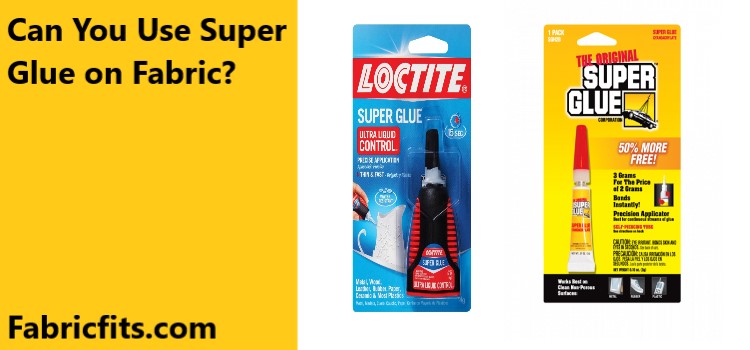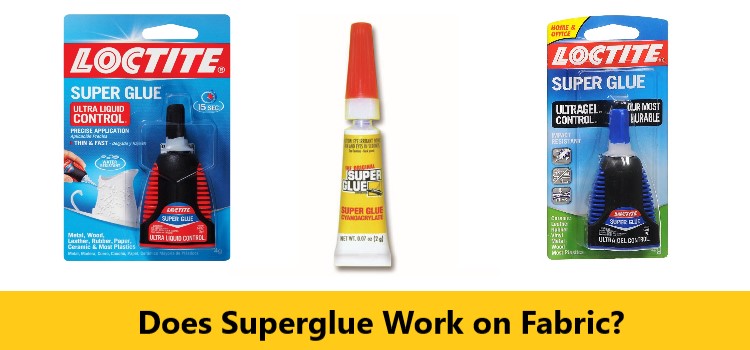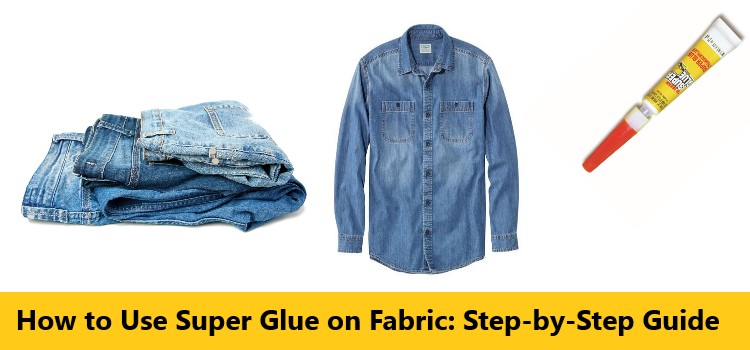Super glue is the emergency savior against my embarrassment when things snap.
I have had to come up with many on-the-deck solutions in precarious moments. Using super glue is one. But the last few incidents resorted me to lean toward this glue for fabrics on different occasions.

If you plan on using the adhesive on purpose, the inner voice will ask you this – can you use super glue on fabric?
Yes, you can use it at times. However, Super glue is not crazy about fabric because it sometimes reacts poorly to the soft material with a porous texture. The dried glue transforms the area stiff and plasticized. It should be applied only on desperate measures.
Nevertheless, there is more to meet regarding this powerful glue. Let me illuminate you further.
Table of Contents
Can You Use Super Glue on Fabric?
In a similar vein, can super glue be used on fabric, or should you? I suggest applying it on little tears and cuts.
As mentioned earlier, the fabric material is highly porous. The liquid will harden and form a rigid texture no matter how much you try it flex it.

Moreover, it is a risky endeavor when applied over wool, cotton, etc. The glue burns the fibers rapidly upon polymerization due to the heat the substance generates.
Therefore, there is no guarantee that the bond will remain for a long time. The fabric will lose its drape and smooth effect even after washing, leaving an unattractive plasticized patch.
Your best resort is to keep a fabric glue within reach for emergencies. Since it is made specifically for fabric, you will not have to go through the stiff predicament as super glue conveys.
Nevertheless, it will also wash away during laundry, so consider it for temporary and small applications.
Fabric glue is compatible with vinyl, denim, leather, cotton, wool, etc.
What is Super Glue Used for?
You can use super glue when a plastic toy snaps in two, which happens more than you can count. Some use it to put together a glass vase; others use it for chipped wood in an upholstery.

People who create wondrous crafty items utilize superglue for strong bondage between cardboard pieces often.
The examples will fill the page as you think about it. Still, the basic line is that acrylic resin and other ingredients produce such an efficient bond that it can adhere to any material type.
You can glue plastic, wood, paper, metal, fabric, and so forth.
There were even moments when it managed to piece together tow component of a heavy duty plastic equipment. Keep in mind that the lifespan of this adhesive relies on the material where you applied the glue.
For instance, it acquires greater bond between two like objects, specifically when they are non-porous/semi-porous.
Highly permeable objects find it difficult to connect when super glue is used. The material rather absorbs the substance than allows adhesion.
Does Superglue Work on Fabric?
Super glue is a quick solution to rapid mending – this much is true. However, does it work on fabric the same way it does on hard materials?
Instead of opting for a sewing kit, the super glue may provide a temporary fix on the spot. However, it is not for the long haul, and you should use it only if no other alternative is in sight.

Super glue on fabric is unreliable, especially on soft and pliable cloth. The stiff curing on a fabric piece will be noticeable despite creating a powerful bond. Believe me when I say this, the stain is hideous on darker garments.
You cannot apply excessive glue liquid, too, as it will minimize your movement flexibility. The experience will be uncomfortable throughout the day.
With so many disadvantages hanging on one side of the scale, what really balances its use? If you learn how to apply it, you can benefit from it when nothing else is around to rescue the day.
How to Use Super Glue on Fabric: Step-by-Step Guide
Why does superglue work better on less porous items? It is because of the rigidity and inflexibility these objects contribute. Fabric is completely the opposite. It is flowy and will move a lot.

As a result, the bond may not last for long. If you are still firm on using super glue on fabric or if the application is unavoidable, remember a few things:
- Wet the fabric before applying super glue. It helps form a stronger bond.
- Utilize the glue layer very lightly.
- Always start by reading the clothing/fabric maintenance tags for less damage.
- Try using the glue only in areas/patches that do not get much movement or do not stretch too often. Otherwise, the shift will cause the adhesive to loosen, become flaky, and be visible to the eyes.
- Opt for super glue on fabric as a temporary fix.
- You can wash the fabric/clothing item in the washer to remove the residues before it can damage the piece.
Pros & Cons of Using Super Glue on Fabric
The only reason for this superglue alternative is that you are either in a hurry or do not carry a sewing tool kit everywhere you go to cover the imperfection.
It is quite alright. The fast bonding adhesive does the work for the time being. Yet, there are some benefits to super glue application on fabric.
Pros:
- Super glue is a superb adhesive for quick fixes on fabrics.
- It dries faster than any regular liquid glue.
- You can purchase the tiny tube at a relatively low price. A cost-effective means to hurried fabric repairs.
- The product is easily available in any store.
- Its application method is extremely simple, right out of the tube.
Every advantageous point creates an adverse effect to counterbalance its use. Superglue is no exception. Here are some of those.
Cons:
- An uneven super glue layer or excessive application will damage the fabric by wrinkling.
- Too little application, on the contrary, will form a poor bond.
- Removing super glue residues after it dries on the fabric is pretty challenging.
- Some fabric may react badly to the glue, making the fibers burn or too stiff to work with.
Here is my all-time suggestion for the new super glue holders – test a little corner of the fabric with the glue first and see the reaction. Then decide whether you should use it for mending.
Read Next: Guide on using tacky glue on fabric
Why Does Super Glue Get Hot on Fabric?
The expression that comes to mind for this question is ‘spontaneous combustion.’ I find it a phenomenal response to the rapid catching on fire of certain objects.
There is nothing on the item, and it still catches fire. It takes place when the chemical blend forms a complex or miscalculated reaction.
This combustion happens so fast and unexpectedly that you can do nothing but be the spectator.
Now, what does that have anything to do with superglue? Do you recall my advice against using superglue on fabric earlier?
When you apply the crazy glue on less porous objects, it releases energy to form heat. We do not feel it as the glue substance blends with the two objects to bond.
Conversely, the same energy is released as you apply the glue to the fabric. But this time, the heat it forms reacts with the porous item, creating a potential spontaneity to combustion.
The heat created due to chemical reactions can burn your skin if handled inadequately. If you ignore the bubbling burning reaction and continue to apply the glue, there is a chance of starting a full combusting flame!
How Does Super Glue Affect Different Fabrics?
We do not always have the right tools in our hands when needed. Consider the super glue like those apparatuses you obtain easily for a swift repair.
Hence, it is not a bad idea to have one around you for emergencies. It also means learning how different fabric items react to the adhesive in case no more forestalling is possible.
Cotton
Never underestimate the chemical reaction the crazy, aka super glue, can create upon contact with cotton.
While cotton is my daily garment choice, it is also susceptible to rips at times. Suppose you wore a cotton dress to a gathering, and it obtained a small tear.
Not everyone owns a sewing kit right at hand, so the only reasonable logic you come to is the super glue. It is found practically in every household but should you go for it?
Cotton fibers react rapidly to the glue ingredients and can burn the skin underneath. It can even generate fire in the worst-case scenario.
I say you let the rip be stitched later instead of gluing with acrylic resin for your safety. You can opt for little safety pins or fabric pins if the tear seems too wide.
Create a fashion on the go!
Polyester
This fabric type is also known as synthetic or man-made fabric. Polyester’s chief element is petroleum. The textile industries blend polyester with other fabric types to form a stronger material.
In this sense, polyester is everywhere. So, does the polyester fiber respond well to superglue?
Although the glue will maintain its task of adhesion, the fabric might succumb to highly noticeable stains.
It will have a significant effect on fiber strength, eventually ruining the clothing item.
Tell me, will you want to wear or put on a large stained polyester fabric after the damage?
Wool
Once again, cyanoacrylate is a great kit to have in hand. Did you know many first aid kits or survival kits contain a tube of superglue?
Do you think it is for mending a rip? No, it is for making fire, so you can call for help or let the rescuers pinpoint your location.
But you must have something else for the glue to react with. Wool is one of those fabrics that deliver rapid chemical reactions by releasing heat. This heat generated will cause a minor burn for you to create a sizable fire.
So, do you want to superglue your favorite wool sweater while you are wearing it? Consider wool as the greatest enemy of the father of glue from this day on.
Nylon
This fabric type is also a family of synthetic polymers. Nylon is used to make versatile apparels that comprise no organic materials.
Furthermore, the fabric screams permeability in every stage, even though it is better to avoid it during summer/humid weather.
It is because the fabric traps heat, restricting your skin from breathing. The polished texture of this makes any glue adhere well.
Yes, superglue falls in this group due to short-term longevity. You can use the glue on nylon, but it will come apart soon.
Leather
We all know that leather is a natural fabric material made from organic, tanned animal skin. You should also know that leather offers variations according to different finishes.
There is artificial leather as well. Whatever you say, the fabric is used widely for bags, sofas, jackets, etc.
Suppose you notice a tear on a leather sofa that is difficult to ignore at the moment. Should you grab that super glue tube? You can apply the glue, but it will limit the freedom of movement and flow.
The glued surface will become stiff and brittle after curing.
Final Words
Lastly, does super glue work on fabric and get away with it? I am able to provide you with the information throughout the guide because I used it myself.
On more than one occasion, I have been reliant on super glue to save me from awkward encounters. While super glue may not be the ideal choice for quick fixes on fabrics, it is better to store one in a bag pocket for urgent situations.
If you face too many tears and rips all the time, I recommend hiding one of those small sewing kits in the purse!
